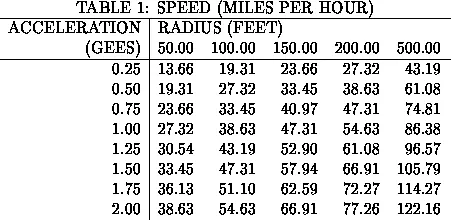No Bucks Racing Club
P.O. Box 662
Burbank, CA 91503
(C)Copyright 1991
One often hears of "centrifugal force." This is the apparent force that throws you to the outside of a turn during cornering. If there is anything loose in the car, it will immediately slide to the right in a left hand turn, and vice versa. Perhaps you have experienced what happened to me once. I had omitted to remove an empty Pepsi can hidden under the passenger seat. During a particularly aggressive run (something for which I am not unknown), this can came loose, fluttered around the cockpit for a while, and eventually flew out the passenger window in the middle of a hard left hand corner.
I shall attempt to convince you, in this month's article, that centrifugal force is a fiction, and a consequence of the fact first noticed just over three hundred years ago by Newton that objects tend to continue moving in a straight line unless acted on by an external force.
When you turn the steering wheel, you are trying to get the front tires to push a little sideways on the ground, which then pushes back, by Newton's third law. When the ground pushes back, it causes a little sideways acceleration. This sideways acceleration is a change in the sideways velocity. The acceleration is proportional to the sideways force, and inversely proportional to the mass of the car, by Newton's second law. The sideways acceleration thus causes the car to veer a little sideways, which is what you wanted when you turned the wheel. If you keep the steering and throttle at constant positions, you will continue to go mostly forwards and a little sideways until you end up where you started. In other words, you will go in a circle. When driving through a sweeper, you are going part way around a circle. If you take skid pad lessons (highly recommended), you will go around in circles all day.
If you turn the steering wheel a little more, you will go in a tighter circle, and the sideways force needed to keep you going is greater. If you go around the same circle but faster, the necessary force is greater. If you try to go around too fast, the adhesive limit of the tires will be exceeded, they will slide, and you will not stick to the circular path-you will not "make it."
From the discussion above, we can see that in order to turn right, for example, a force, pointing to the right, must act on the car that veers it away from the straight line it naturally tries to follow. If the force stays constant, the car will go in a circle. From the point of view of the car, the force always points to the right. From a point of view outside the car, at rest with respect to the ground, however, the force points toward the center of the circle. From this point of view, although the force is constant in magnitude, it changes direction, going around and around as the car turns, always pointing at the geometrical center of the circle. This force is called centripetal, from the Greek for "center seeking." The point of view on the ground is privileged, since objects at rest from this point of view feel no net forces. Physicists call this special point of view an inertial frame of reference. The forces measured in an inertial frame are, in a sense, more correct than those measured by a physicist riding in the car. Forces measured inside the car are biased by the centripetal force.
Inside the car, all objects, such as the driver, feel the natural inertial tendency to continue moving in a straight line. The driver receives a centripetal force from the car through the seat and the belts. If you don't have good restraints, you may find yourself pushing with your knee against the door and tugging on the controls in order to get the centripetal force you need to go in a circle with the car. It took me a long time to overcome the habit of tugging on the car in order to stay put in it. I used to come home with bruises on my left knee from pushing hard against the door during an autocross. I found that a tight five- point harness helped me to overcome this unnecessary habit. With it, I no longer think about body position while driving-I can concentrate on trying to be smooth and fast. As a result, I use the wheel and the gearshift lever for steering and shifting rather than for helping me stay put in the car!
The 'forces' that the driver and other objects inside the car feel are actually centripetal. The term centrifugal, or "center fleeing," refers to the inertial tendency to resist the centripetal force and to continue going straight. If the centripetal force is constant in magnitude, the centrifugal tendency will be constant. There is no such thing as centrifugal force (although it is a convenient fiction for the purpose of some calculations).
Let's figure out exactly how much sideways acceleration is needed to keep a car going at speed
Consider a very short interval of time, far less than a second. Call it
What was not appreciated before we went through this derivation is that the necessary acceleration increases as the square of the velocity. This means that the centripetal force your tires must give you for you to make it through a sweeper is very sensitive to your speed. If you go just a little bit too fast, you might as well go much too fast-you're not going to make it. The following table shows the maximum speed that can be achieved in turns of various radii for various sideways accelerations. This table shows the value of the expression

For autocrossing, the columns for 50 and 100 feet and the row for 1.00
The absolute fastest way to go through a corner is to be just over the limit near the exit, in a controlled slide. To do this, however, you must be pointed in just such a way that when the car breaks loose and slides to the exit of the corner it will be pointed straight down the optimal racing line at the exit when it "hooks up" again. You can smoothly add throttle during this maneuver and be really moving out of the corner. But you must do it smoothly. It takes a long time to learn this, and probably a lifetime to perfect it, but it feels absolutely triumphal when done right. I have not figured out how to drive through a sweeper, except for the exit, at anything greater than the limiting velocity because sweepers are just too long to slide around. If anyone (Ayrton Senna, perhaps?) knows how, please tell me!
The chain of reasoning we have just gone through was first discovered by Newton and Leibniz, working independently. It is, in fact, a derivation in differential calculus, the mathematics of very small quantities. Newton keeps popping up. He was perhaps the greatest of all physicists, having discovered the laws of motion, the law of gravity, and calculus, among other things such as the fact that white light is made up of multiple colors mixed together.
It is an excellent diagnostic exercise to drive a car around a circle marked with cones or chalk and gently to increase the speed until the car slides. If the front breaks away first, your car has natural understeer, and if the rear slides first, it has natural oversteer. You can use this information for chassis tuning. Of course, this is only to be done in safe circumstances, on a rented skid pad or your own private parking lot. The police will gleefully give you a ticket if they catch you doing this in the wrong places.
[hr]
converted by: rck@home.net
Thu Sep 29 14:04:41 PDT 1994




